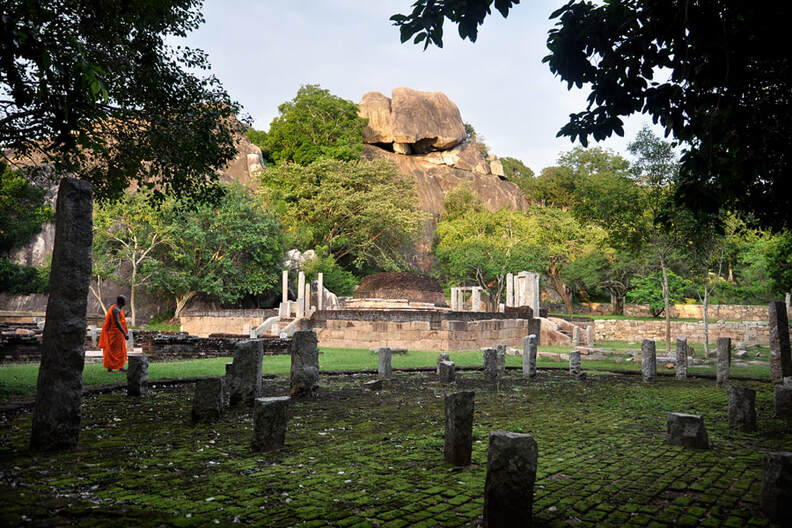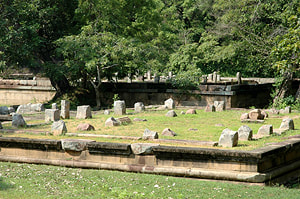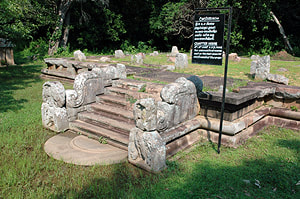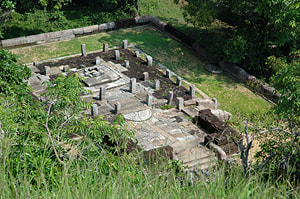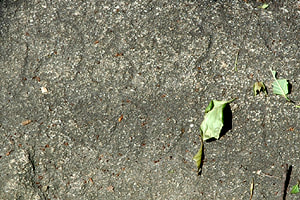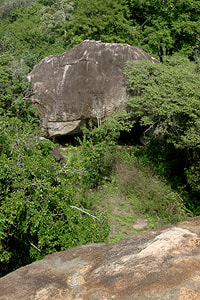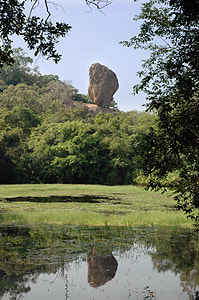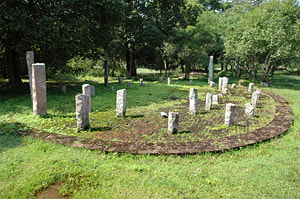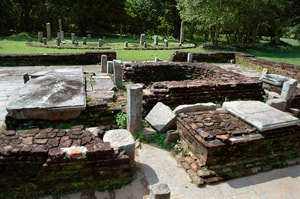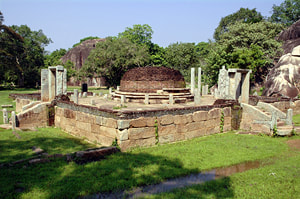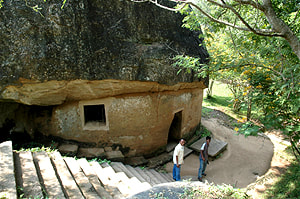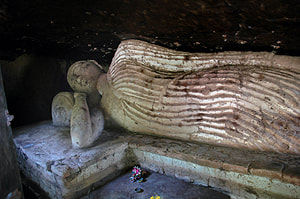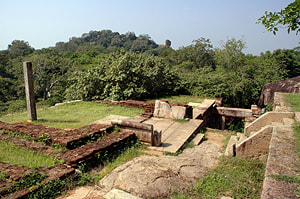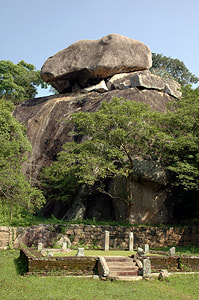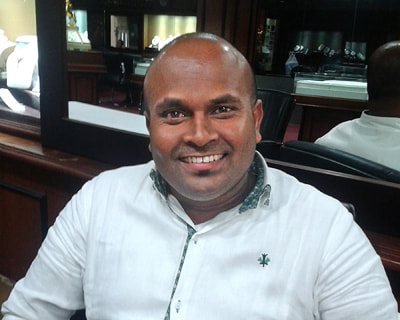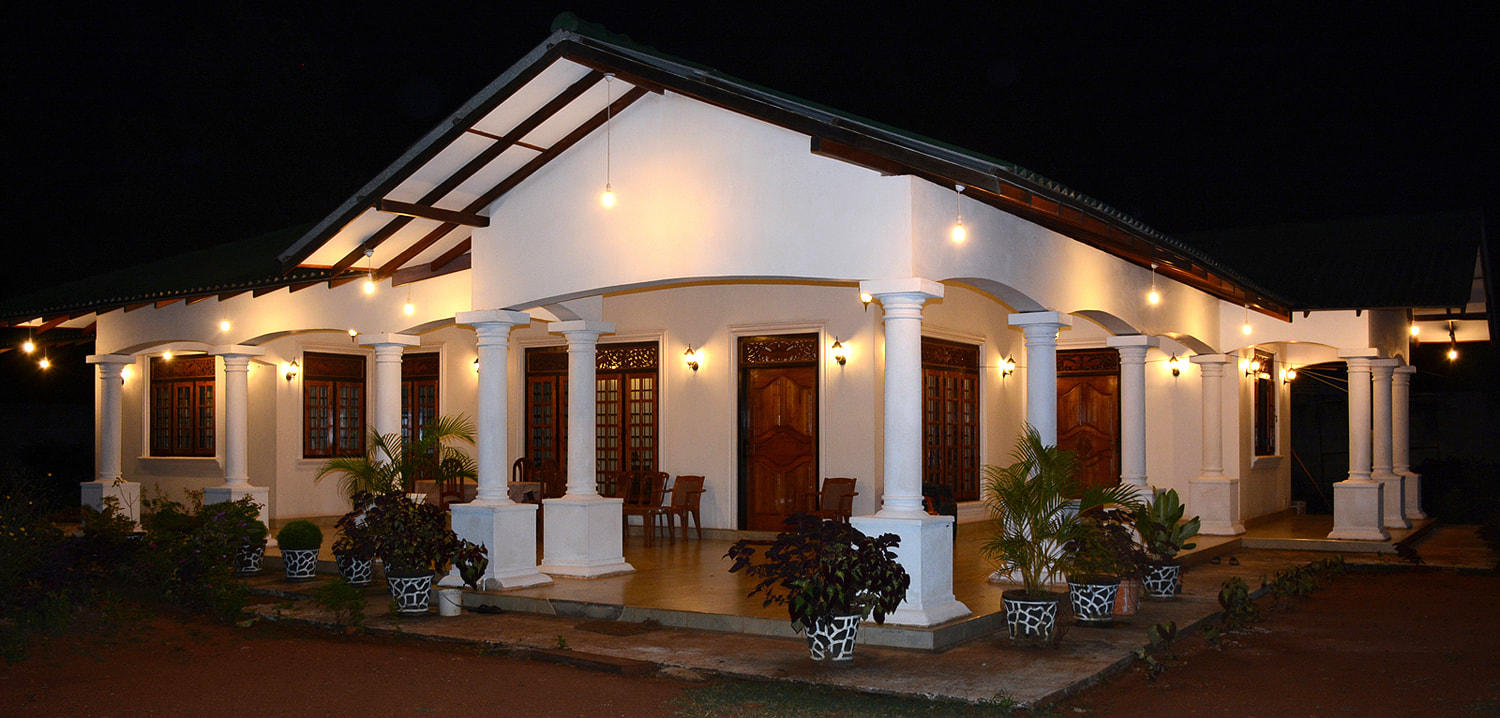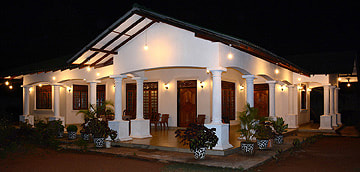Haththikuchchi is rarely visited by foreigners, though it's in only half an hour driving distance from the hub Anuradhapura. The ruined monastic complex is situated in an highly attractive arcadian setting, framed by rock boulders.
|
The charming heritage site now renamed "Haththikuchchi" is believed to be the place where Sri Lanka's by far most popular king, Sirisanghabo, though a layman and thus not enlightend, was venerated as a kind of "Buddhist saint" already during the Anuradhapura period. His pious meritorious deeds and ultimate sacrifyace had finally triumphed over his rival's violence. Ruins of the ancient pilgrimage site at the king's burial place have been excavated and partly restored recently.
|
Content of our Haththikuchchi page: Sirisanghabo Story in short What to see: Uposathagara - Patimagara - Cave Inscription - Jantagara - Cave Kutis - Ugulgala - Asanagara - Bodhigara - Chetiyagara - Reclining Buddha - Padhanagara - Sirisanghabo Cave Sirisanghabo Tales in the Chronicles |
|
„Haththikuchchi“, also transcibed „Hatthikucchi“, is a Pali word literally meaning „elephant‘s stomach“. The ruined temple complex formerly called by the name of the nearby village „Rayangane“ or „Rajangane“, has been renamed „Hatthikucchi“ after an inscripition was discovered identifying this place as that Hatthikucchi mentioned by the ancient scholar Buddhaghosa, who wrote it was one of those monasteries which attracted so many pilgrims that reclusive monks could not live there undisturbed by the crowds.
Though situated in only 35 kilometers distance south-southwest of Anuradhapura, Hatthikucchi belongs to the Kurunegala District of the neighbouring Northwestern Province, which is also called „Wayamba“. |
Haththikuchchi -
Setting of Sri Lanka's most famous royal drama:
the story of King Sirisanghabo
A first Buddhist temple at this site is considered to have been built already in the first phase of the Buddhist period, namely by King Devanampiyatissa in the 3rd century B.C. But it must have fallen into decay already in antiquity. When King Sirisanghabo settled down here in a cave, he had chosen this place, because it was a forest only inhabited by animals.
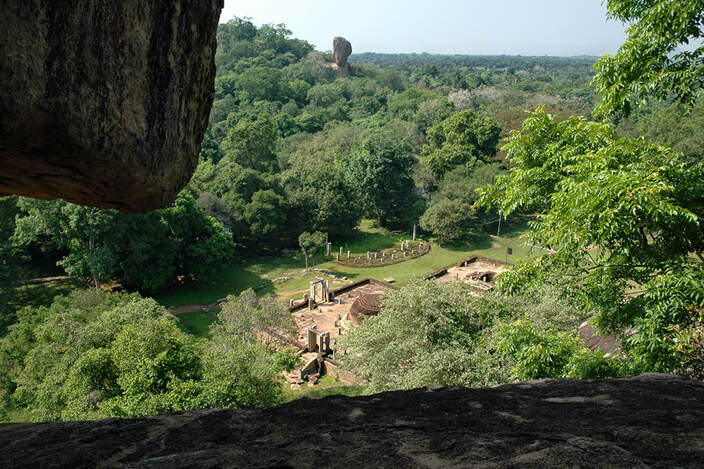 view from Sirisanghabo's cave to the Chetiyaghara below and the Ugulgala in the background
view from Sirisanghabo's cave to the Chetiyaghara below and the Ugulgala in the background
Although King Sirisanghabo only ruled two years and did neither fight battles nor construct significant monuments, his name is still known by all Sri Lankans, since he is the paragon of a pious Buddhist king. In order to prevent convicted criminals from being executed, he secretly exiled them instead. But to maintain the deterrent effect of capital punishment, beheaded bodies of other persons who had already died of natural causes were shown to the people.
Another story goes: When a flesh-eating demon haunted the people, the king offered his own life to sooth the monster.
King Sirisanghabo‘s most famous deed, of course, is sacrificing his life by beheading himself, for the sake of a poor man. So the story goes:
Sirisanghabo‘s former companion and finance minister Gothabhaya decided to stage a coup to occupy the throne. When the righteous King Sirisanghabo was alarmed that the rebel army approached the capital, he decided not to fight against them, since a civil war would cost human lives. Instead of being involved in a power struggle, King Sirisanghabo decided to abdicate and to lead a reclusive life in the jungles, just happy to be freed from the burden of governance. The gruesome usurper Gothabhaya soon consolidated his power by executing Sirisanghabo‘s ministers and supporters. But becausae Gothabhaya could not believe or even imagine that Sirisanghabo would be without any ambition to fight for the throne, he began to fear that the lawful king might plot and prepare his future return to the throne. This is why the usurper offered a reward for the head of the dethroned king.
Meanwhile Srisanghabodhi settled doown in a tranquil hermitage and spend the day meditating and enjoying the friendship of the forest creatures. He came to know that the bounty was announced. But he he was not overly concerned about this, since he had contact with only very few people, who were friendly with him. One day the abdicated king met a poor peasant, who was kind to share a meal with him. During that meal, the poor man told that he was searching for Sirisanghabo, because he could use the reward for his family in need. Then Sirisanghabo came forward and identified himself and offered his head. The peasant, shocked and frightened, then said he was unable to kill him. So Sirisanghabo found a way that the poor man would not have to commit murder. He took out his own knife, cut off his own head and handed it to the horrified peasant. Gothabhaya first triumphed when this head brought by the peasant finally turned out to be the authentic one, because the head spoke: „I am Sirisanghabo“. But soon he became horrified, since the decapitation of the lawful king made the usurper look even worse in the eyes of the people. Finally, Gothabhaya regretted his deeds by becoming a peaceful and just king. He soon built a memorial stupa for the dead king at the burial place of the decapitated body and declared it a sanctuary. So Srisanghabodhi’s self-sacrifice turned out to have a transforming effect on the new king, for the benefit of the people.
For many centuries it has been considered that those incidents took place at Attanagalla in Gampaha District, where Sirisanghabo is venerated till the present day and a cave can be seen which is claimed to be the hideout where the famous king once lived in the jungles. However, in recent times most scholars have raised the argument that the ruins closer to Anuradhapura, now renamed „Haththikuchchi“ must have been the hermitage where Sirisanghabo lived and the pilgrimage site where his sacrifice was commemorated during the Anuradhapura period. Besides the identification of the said inscription, one more reason for this assumption is that the story tells the peasant had walked only half a day from Anuradhapura southwards when meeting the abdicated king. But Attanagalla, which is 170 km from Anuradhapura, can not be reached walking half a day. Another reason for identifying present-day Hatthikuchchi as Sirisangabo‘s last abode is that the ruins seem to be more of that kind of buildings described in the chronicles, which claim that a memorial was built and a pilgrimage place came to existence soon after Sirisanghabo‘s self sacriface.
Another story goes: When a flesh-eating demon haunted the people, the king offered his own life to sooth the monster.
King Sirisanghabo‘s most famous deed, of course, is sacrificing his life by beheading himself, for the sake of a poor man. So the story goes:
Sirisanghabo‘s former companion and finance minister Gothabhaya decided to stage a coup to occupy the throne. When the righteous King Sirisanghabo was alarmed that the rebel army approached the capital, he decided not to fight against them, since a civil war would cost human lives. Instead of being involved in a power struggle, King Sirisanghabo decided to abdicate and to lead a reclusive life in the jungles, just happy to be freed from the burden of governance. The gruesome usurper Gothabhaya soon consolidated his power by executing Sirisanghabo‘s ministers and supporters. But becausae Gothabhaya could not believe or even imagine that Sirisanghabo would be without any ambition to fight for the throne, he began to fear that the lawful king might plot and prepare his future return to the throne. This is why the usurper offered a reward for the head of the dethroned king.
Meanwhile Srisanghabodhi settled doown in a tranquil hermitage and spend the day meditating and enjoying the friendship of the forest creatures. He came to know that the bounty was announced. But he he was not overly concerned about this, since he had contact with only very few people, who were friendly with him. One day the abdicated king met a poor peasant, who was kind to share a meal with him. During that meal, the poor man told that he was searching for Sirisanghabo, because he could use the reward for his family in need. Then Sirisanghabo came forward and identified himself and offered his head. The peasant, shocked and frightened, then said he was unable to kill him. So Sirisanghabo found a way that the poor man would not have to commit murder. He took out his own knife, cut off his own head and handed it to the horrified peasant. Gothabhaya first triumphed when this head brought by the peasant finally turned out to be the authentic one, because the head spoke: „I am Sirisanghabo“. But soon he became horrified, since the decapitation of the lawful king made the usurper look even worse in the eyes of the people. Finally, Gothabhaya regretted his deeds by becoming a peaceful and just king. He soon built a memorial stupa for the dead king at the burial place of the decapitated body and declared it a sanctuary. So Srisanghabodhi’s self-sacrifice turned out to have a transforming effect on the new king, for the benefit of the people.
For many centuries it has been considered that those incidents took place at Attanagalla in Gampaha District, where Sirisanghabo is venerated till the present day and a cave can be seen which is claimed to be the hideout where the famous king once lived in the jungles. However, in recent times most scholars have raised the argument that the ruins closer to Anuradhapura, now renamed „Haththikuchchi“ must have been the hermitage where Sirisanghabo lived and the pilgrimage site where his sacrifice was commemorated during the Anuradhapura period. Besides the identification of the said inscription, one more reason for this assumption is that the story tells the peasant had walked only half a day from Anuradhapura southwards when meeting the abdicated king. But Attanagalla, which is 170 km from Anuradhapura, can not be reached walking half a day. Another reason for identifying present-day Hatthikuchchi as Sirisangabo‘s last abode is that the ruins seem to be more of that kind of buildings described in the chronicles, which claim that a memorial was built and a pilgrimage place came to existence soon after Sirisanghabo‘s self sacriface.
What to see in Haththikuchchi
|
How to visit Haththikuchchi
The easiest way to visit Hatthikuchchi is, of course, to stay in my guesthouse in Mihintale, First House, and to book a half-day excursion, combining visits of Hatthikucchi and of other less-crowded places such as Vessagiriya in Anuradhapura South.
The very same half-day itinerary is offered by Lanka Excursions Holidays for all heritage travellers, who spend some days in the ancient capital Anuradhapura. We can pick you up at any hotel in and around in Anuradhapura in case of booking at least one day in advance. Just call: 071 6097795 Or mail: nuwan@[email protected] Or send a quick inquiry: Find our reviews here...
Or on Tripadvisor here...
First House Mihintale is a perfect starting point for sightseeing in and around Anuradhapura and excursions to places of interest such as Haththikuchchi, Thanthirimale, Kirilagala, and Wilpattu National Park.
Mihintale is a more tranquil and relaxed place than Anuradhapura New Town, perfect for those holiday makers who intend to stay more than just one night near Sri Lanka's most famous ancient capital. The distance from First House Mihintale to the Archaological Park of Anuradhapura World Heritage Site is only 13 km, compared to 6 km from the guesthouse are in Anuradhapura New Town. Travellers starting their tour from Negombo or Colombo can visit Haththikuchchi on the way to Anuradhapura or Mihintale. Find a list of half-day and full-day excursions from Anuradhapura or Mihintale to charming Haththikuchchi and other nearby attractions here...
Find a list of other ancient temples which could be of interest for heritage tours in Sri Lanka here...
|
Sirisanghabo Tale in Sri Lanka's ancient chronicles
The most ancient of Sri Lanka's Pali chronicles is the Dipavamsa, written in the 4th or 5th century A.D. It mentions meritorious deeds of King Sirisanghabo, though only typical charitable acts, namely alms-giving and food-destribution. The Dipavamsa narratice does not include the famous story of self-decapitation.
Quotation from the Dipavamsa, Verses 22,53-54
|
King Saṃghabodhi by name was a virtuous prince; this king reigned two years. This victorious king ordered rice-milk continually to be distributed in the delightful Meghavana garden, and in the most excellent Mahavihara he constructed a room where food was distributed by tickets
cited from: Oldenberg, Hermann. Dīpavaṃsa: an ancient Buddhist historical record. Oxford: Pali Text Society, 1879. Page 219 |
Sri Lanka's most famous chronicle was written by the Monk Mahanama one century later. The Mahavamsa account of the reign of King Sirisanghabo is much more comprehensive. It already contains all the Sirisanghabo legends which are famous and popular with Sri Lankans till the present day.
Excerpt from Chapter 36 of the Mahavamsa
|
Sirinaga’s son named VIJAYA-KUMARAKA reigned for one year after his father’s death.
(At that time) three Lambakannas lived in friendship at Mahiyangana: Samghatissa and Samghabodhi, the third being Gothakabhaya. When they were coming (to Anuradhapura) to do service to the king, a blind man who had the gift of prophecy, being by the edge of the Tissa-tank, cried out at the sound of their footsteps: `The ground bears here three rulers of the earth!’ As Abhaya, who was walking last, heard this he asked (the meaning of the saying). The other uttered yet again (the prophecy). `Whose race will endure ?’ then asked again the other, and he answered: `That of the last.’ When he had heard that he went (on) with the two (others). When they were come into the capital the three, being the close and trusted (counsellors) of the king, remained in the royal service about the king. When they together had slain king Vijaya in his royal palace the two (others) consecrated SAMGHATISSA, the commander of the troops, as king. Thus crowned did Samghatissa reign four years in stately Anuradhapura. [. . . ] From time to time the king, with the women of the royal household and the ministers, used to go to Pacinadipaka to eat jambu-fruits. Vexed by his coming the people dwelling in Pacinadipa poisoned the fruit of the jambu-tree from which the king was to eat. When he had eaten the jambu-fruits he died forthwith even there. And Abhaya consecrated as king Samghabodhi who was charged with the (command of) the army. The king, who was known by the name SIRISAMGHABODHI, reigned two years in Anuradhapura, keeping the five precepts. In the Mahavihara he set up a beautiful salaka-house. When the king heard that the people of the island were come to want by reason of a drought he himself, his heart shaken with pity, lay down on the ground in the courtyard of the Great Thüpa, forming the resolve: `Unless I be raised up by the water that the god shall rain down I will nevermore rise up from hence, even though I die here.’ As the ruler of the earth lay there thus the god poured down rain forthwith on the whole island of Lanka, reviving the wide earth. And even then he did not yet rise up because he was not swimming in the water. Then his counsellors closed up the pipes by which the water flowed away. And as he now swam in the water the pious king rose up. By his compassion did he in this way avert the fear of a famine in the island. At the news: `Rebels are risen here and there,’ the king had the rebels brought before him, but he released them again secretly; then did he send secretly for bodies of dead men, and causing terror to the people by the burning of these he did wawy with the fear from rebels. A yakkha known as Ratakkhi, who had come hither, made red the eyes of the people here and there. If the people did but see one another and did but speak of the redness of the eyes they died forthwith, and the yakkha devoured them without fear. When the king heard of their distress he lay down with sorrowful heart alone in the chamber of fasting, keeping the eight uposatha vows, (and said): `Till I have seen the yakkha I will not rise up.’ By the (magic) power of his piety the yakkha came to him. To the king’s (question): `Who art thou?’ he answered: `It is I, (the yakkha).’ `Why dost thou devour my subjects? Swallow them not!’ `Give up to me then only the people of one region,’ said the other. And being answered: `That is impossible,’ he came gradually (demanding ever less and less) to one (man) only. The (king) spoke: `No other can I give up to thee; take thou me and devour me.’ With the words: `That is impossible,’ the other prayed him (at last) to give him an offering in every village. `It is well,’ said the king, and over the whole island he decreed that offerings be brought to the entrance of the villages, and these he gave up to him. Thus by the great man, compassionate to all beings, by the torch of the island was the fear pestilence brought to an end. The king’s treasurer, the minister Gothakabhaya, who had become a rebel, marched from the north against the capital. Taking his water-strainer with him the king fled alone by the south gate, since he would not bring harm to others. A man who came, bearing his food in a basket, along that road entreated the king again and again to eat of his food. When he, rich in compassion, had strained the water and had eaten he spoke these words, to show kindness to the other: `I am the king Samghabodhi; take thou my head and show it to Gothabhaya, he will give thee much gold.’ This he would not do, and the king to render him service gave up the ghost even as he sat. And the other took the head and showed it to Gothabhaya and he, in amazement of spirit, gave him gold and carried out the funeral rites of the king with due care. Thus GOTHABHAYA, also known as Meghavannabhaya, ruled thirteen years over Lanka. cited from: http://mahavamsa.org/mahavamsa/original-version/36-thirteen-kings/ (retrieved: 13 January 2023) |
A comprehensive Sirisanghabo-storybook called Hatthavanagallaviharavamsa
The most detailed Sirisanghabo tale is found in eight of the eleven chapters of the Hatthavanagallaviharavamsa. Admittedly, at first sight the name of this chronicle may be baffling. Nonetheless, it's easily understandable how it got its very, very long name. "Hattha-vana-galla-vihara-vamsa" translates to "Elephant-grove-rock-monastery-chronicle". So it's just the chronicle of a monastery bearing the name of an Elephant forest-rock. The modern name of this monastery was already mentioned above. It's Attanagala in Gampaha District, which has been recognized as the place of Sirisanghabo's self-sacrifice for many centuries - a claim now contested by Haththikuchchi. The chronicle tells the history of Attanagala from the times of Sirisanghabo till the reign of Parakramabahu II. By far the largest part of this chronicle is dedicated to just these two kings.
Parakramabahu II, who ruled in the mid 13th century was the most important Sinhalese king of the Dambadeniya period. The Dambadeniya kings claimed kinship with Sinhalese kings from the previous Polonnaruwa period. But since those relations to the Polonnaruwa dynasties were not very close, if they existed at all, the Dambadeniya kings created another lineage, holding descent from the Anuradhapura kings of the Lambakanna dynasty. Most of the Anuradhapura kings were from this royal family. The Lambakannas claimed to be of Indian ancestry. Their ancestor was Sumitta, a prince of the Indian Mauriyan clan, who had belonged to the escort that brought the Bodhi-tree from India to Sri Lanka. One name of this tree or of its escort is "Holy assembled Enlightenment". The Pali word for it is "Siri Sangha Bodhi", abbreviated to "Sirisanghabo". Thus, the Dambadeniya kings called their new dynastie "Sirisanghabo". Not surprisingly, they had a special interest in the first king of the ancient Lambakanna dynasty bearing that very same name: Sirisanghabo.
And there is another reason for narrating the Sirisanghabo story anew in a chronicle of the Dambadeniya period. King Parakramabahu II from Dambadeniya favoured a monk called Anomadassi. This Buddhist cleric was the chief incumbent of the Atthavanagalla monastery, the temple where Sirisanghabo was venerated during that period. The date of the Hatthavanagallaviharavamsa and the name of its author are not mentioned anywhere. But in the beginning of this chronicle the writer says he composed it at the request of the Anomadassi. Thus it was probably written during the reign of King Parakramabahu II.
The Hatthavanagallaviharavamsa is not only a record of a monastery's history. It's also a kind of "mirror for princes". The Bodhisattva-like King Sirisanghabo is chosen as perfect example of a Buddhist ruler, willing to sacrifice himself for the benefit of the people and poor individuals in particular. The entire second chapter is about virtues of a king and rules of good government.
The heroic epic of King Sirisanghabo is composed in poetic form. The work is praised for its simple elegance. That's why it is still in use in present-day education of monks learning the Pali language, since this ballade is perfect for studying the grammar of Pali.
The Sirisabghabo legend became increasingly popular in the late Middle Ages. The Hatthavanagallaviharavamsa was translated into Sinhala during the reign of Parakramabahu VI. from Kotte, who was the greatest patron of Sinhalese literature ever. The most popular Sinhala translation of the ballade is from the 18th century. It was written by the then chief incumbent of the Attanagala monastery.
Compared to the Mahavamsa record, there are some alterations and supplements in the Hatthavanagallaviharavamsa epic. For example, the two companions, one of whom was Gothabhaya, are now presented as Sirisanghabo's own brothers. When Sirisanghabo ascended the throne, many courtiers shook their heads, because they thought that such a mild person would be incapable of reigning a kingdom. The detailed account of the conversation between abdicated king and the headhunting peasant is from the later chronicle. The story of the talking head, confirming to be the authentic Sirisanghabo, is from the Hatthavanagallaviharavamsa, too, it's not found in the Mahavamsa, see above. Similarly, that many innocents were decapitated by greedy persons in order to get the bounty for handing out a head, is a supplement from the later period. Sirisanghabo now is believed to have beheaded himself in order to prevent further innocent people to be killed instead of him. One very telling claim made by Sirisanghabo is reported in the Hatthavanagallaviharavamsa. Sirisanghabo says that he is a Bodhisattva. This topic - a king being a future Buddha - is a typical element of the royal ideology of later periods of Sri Lankan history. Though the Mahavamsa account calls Sirisanghabo "great man, compassionate to all beings", it does not yet mention the Bodhisattva title explicitly. However, in later periods Sirisanghabo was considered to be the first Bodhisattva on the Sinhalese throne.
There is another diffence between the Mahavamsa and the Hatthavanagallaviharavamsa accounts of the Sirisangabo legend, one that is quite remarkable concerning the ideas of perfect Buddhist rule. The Mahavamsa report leaves the impression, that the trick of beheading corpses instead of culprits was sufficient as a deterrent to uphold public order. But the tale of the Hatthavanagallaviharavamsa mentions explicitely, that civil order was on the decline under Sirisanghabo's rule. Nevertheless, he is considered to be a perfect example of a good monarch. Think about it, for one minute. What does this tell about the medieval ideology of ruling, taught in this an Asian nation? The punchline of the Sri Lankan story is: The life and well-being of individuals, even if these human beings are criminals, is of higher value than public order. This finding may come to a surprise to many Westerners and also to fighters for "Asian values" (who are supporters of dictatorship and very often educated at western universities!) whose thought pattern likes to repeat again and again the "wise saying": the West estimates the individual and the East values the community higher. In the case of the growing Sirisanghabo legend, which was told for educational purposes, quite the opposite is true. King Sirisanghabo is highly praised for his humanity towards individuals, despite the negative effects on society at large.
By the way: Christian rulers never (!) abolished capital punishment before the 18th century. There is only one exception from this Christian rule, namely Queen Tamar of Georia (reigning 1184 till 1213). Western philosophers and Church fathers like Augustin explicitely defended the death penalty for the sake of public order. In contrast to the bible and to the corresponding history of bad western human rights records, the sacred scriptures of Buddhism incorporate the rejection of death penalty, namely at the beginning of the 10th chapter of the Dhamapada, which is the key text of moral instruction in Theravada Buddhist countries, the 10th chapter discussing royal power. Another part of the Tipitaka (the Theravada Buddhist Scriptures) is called Jatakas. It contains tales illustrating Buddhist virtues, very similar to the Sirisanghabo legend. One Jataka story goes: After the future Buddha Shakyamuni had been born as Prince Janasandha in one of his previous lives, he ordered the destruction of all places of execution as soon as he became king. Also the "curch father" of Mahayana Buddhism, Nagarjuna, is worth mentioning. He is said to have been the author of a kind of "mirror for princes". This "Rajaparikatha Ratnamala" includes the command to exile murderers instead of killing or tormenting them. Chinese and Korean pilgrims visiting kingdoms of northern India (in the 5th respective 8th century A.D.) were astonished to learn that capital punishment was not practiced. Compare this to Western history and then reconsider popular "wise sayings" about contrasting "Western and Asian values".
Returning to our topic: The Hatthavanagallaviharavamsa also says that a monk found enlightenment, this is became an Arahant, a Buddhist saint, during the reign of King Upatissa, at the end of the 4th century A.D. Former abodes of Arahants have been highly revered places in Sri Lanka. This may be one reason why Haththikuchchi attracted so many pious visitors already in antiquity, as recorded by no less than the greatest Theravada Buddhist scholar of all time, Buddhaghosa.
Parakramabahu II, who ruled in the mid 13th century was the most important Sinhalese king of the Dambadeniya period. The Dambadeniya kings claimed kinship with Sinhalese kings from the previous Polonnaruwa period. But since those relations to the Polonnaruwa dynasties were not very close, if they existed at all, the Dambadeniya kings created another lineage, holding descent from the Anuradhapura kings of the Lambakanna dynasty. Most of the Anuradhapura kings were from this royal family. The Lambakannas claimed to be of Indian ancestry. Their ancestor was Sumitta, a prince of the Indian Mauriyan clan, who had belonged to the escort that brought the Bodhi-tree from India to Sri Lanka. One name of this tree or of its escort is "Holy assembled Enlightenment". The Pali word for it is "Siri Sangha Bodhi", abbreviated to "Sirisanghabo". Thus, the Dambadeniya kings called their new dynastie "Sirisanghabo". Not surprisingly, they had a special interest in the first king of the ancient Lambakanna dynasty bearing that very same name: Sirisanghabo.
And there is another reason for narrating the Sirisanghabo story anew in a chronicle of the Dambadeniya period. King Parakramabahu II from Dambadeniya favoured a monk called Anomadassi. This Buddhist cleric was the chief incumbent of the Atthavanagalla monastery, the temple where Sirisanghabo was venerated during that period. The date of the Hatthavanagallaviharavamsa and the name of its author are not mentioned anywhere. But in the beginning of this chronicle the writer says he composed it at the request of the Anomadassi. Thus it was probably written during the reign of King Parakramabahu II.
The Hatthavanagallaviharavamsa is not only a record of a monastery's history. It's also a kind of "mirror for princes". The Bodhisattva-like King Sirisanghabo is chosen as perfect example of a Buddhist ruler, willing to sacrifice himself for the benefit of the people and poor individuals in particular. The entire second chapter is about virtues of a king and rules of good government.
The heroic epic of King Sirisanghabo is composed in poetic form. The work is praised for its simple elegance. That's why it is still in use in present-day education of monks learning the Pali language, since this ballade is perfect for studying the grammar of Pali.
The Sirisabghabo legend became increasingly popular in the late Middle Ages. The Hatthavanagallaviharavamsa was translated into Sinhala during the reign of Parakramabahu VI. from Kotte, who was the greatest patron of Sinhalese literature ever. The most popular Sinhala translation of the ballade is from the 18th century. It was written by the then chief incumbent of the Attanagala monastery.
Compared to the Mahavamsa record, there are some alterations and supplements in the Hatthavanagallaviharavamsa epic. For example, the two companions, one of whom was Gothabhaya, are now presented as Sirisanghabo's own brothers. When Sirisanghabo ascended the throne, many courtiers shook their heads, because they thought that such a mild person would be incapable of reigning a kingdom. The detailed account of the conversation between abdicated king and the headhunting peasant is from the later chronicle. The story of the talking head, confirming to be the authentic Sirisanghabo, is from the Hatthavanagallaviharavamsa, too, it's not found in the Mahavamsa, see above. Similarly, that many innocents were decapitated by greedy persons in order to get the bounty for handing out a head, is a supplement from the later period. Sirisanghabo now is believed to have beheaded himself in order to prevent further innocent people to be killed instead of him. One very telling claim made by Sirisanghabo is reported in the Hatthavanagallaviharavamsa. Sirisanghabo says that he is a Bodhisattva. This topic - a king being a future Buddha - is a typical element of the royal ideology of later periods of Sri Lankan history. Though the Mahavamsa account calls Sirisanghabo "great man, compassionate to all beings", it does not yet mention the Bodhisattva title explicitly. However, in later periods Sirisanghabo was considered to be the first Bodhisattva on the Sinhalese throne.
There is another diffence between the Mahavamsa and the Hatthavanagallaviharavamsa accounts of the Sirisangabo legend, one that is quite remarkable concerning the ideas of perfect Buddhist rule. The Mahavamsa report leaves the impression, that the trick of beheading corpses instead of culprits was sufficient as a deterrent to uphold public order. But the tale of the Hatthavanagallaviharavamsa mentions explicitely, that civil order was on the decline under Sirisanghabo's rule. Nevertheless, he is considered to be a perfect example of a good monarch. Think about it, for one minute. What does this tell about the medieval ideology of ruling, taught in this an Asian nation? The punchline of the Sri Lankan story is: The life and well-being of individuals, even if these human beings are criminals, is of higher value than public order. This finding may come to a surprise to many Westerners and also to fighters for "Asian values" (who are supporters of dictatorship and very often educated at western universities!) whose thought pattern likes to repeat again and again the "wise saying": the West estimates the individual and the East values the community higher. In the case of the growing Sirisanghabo legend, which was told for educational purposes, quite the opposite is true. King Sirisanghabo is highly praised for his humanity towards individuals, despite the negative effects on society at large.
By the way: Christian rulers never (!) abolished capital punishment before the 18th century. There is only one exception from this Christian rule, namely Queen Tamar of Georia (reigning 1184 till 1213). Western philosophers and Church fathers like Augustin explicitely defended the death penalty for the sake of public order. In contrast to the bible and to the corresponding history of bad western human rights records, the sacred scriptures of Buddhism incorporate the rejection of death penalty, namely at the beginning of the 10th chapter of the Dhamapada, which is the key text of moral instruction in Theravada Buddhist countries, the 10th chapter discussing royal power. Another part of the Tipitaka (the Theravada Buddhist Scriptures) is called Jatakas. It contains tales illustrating Buddhist virtues, very similar to the Sirisanghabo legend. One Jataka story goes: After the future Buddha Shakyamuni had been born as Prince Janasandha in one of his previous lives, he ordered the destruction of all places of execution as soon as he became king. Also the "curch father" of Mahayana Buddhism, Nagarjuna, is worth mentioning. He is said to have been the author of a kind of "mirror for princes". This "Rajaparikatha Ratnamala" includes the command to exile murderers instead of killing or tormenting them. Chinese and Korean pilgrims visiting kingdoms of northern India (in the 5th respective 8th century A.D.) were astonished to learn that capital punishment was not practiced. Compare this to Western history and then reconsider popular "wise sayings" about contrasting "Western and Asian values".
Returning to our topic: The Hatthavanagallaviharavamsa also says that a monk found enlightenment, this is became an Arahant, a Buddhist saint, during the reign of King Upatissa, at the end of the 4th century A.D. Former abodes of Arahants have been highly revered places in Sri Lanka. This may be one reason why Haththikuchchi attracted so many pious visitors already in antiquity, as recorded by no less than the greatest Theravada Buddhist scholar of all time, Buddhaghosa.
Do you like our Haththikuchchi information?
We provide the most detailed information on Haththikuchchi you will find anywhere online. Of course, we do this for promotion puposes.
If you visited Haththikuchchi during one of your holidays in Sri Lanka and also fell in love with this hidden gem or if you enjoyed our travel services or if you simply like our Haththikuchchi information, please share it with others by linking to it or leave a comment on our review page or on social media.
If you visited Haththikuchchi during one of your holidays in Sri Lanka and also fell in love with this hidden gem or if you enjoyed our travel services or if you simply like our Haththikuchchi information, please share it with others by linking to it or leave a comment on our review page or on social media.
